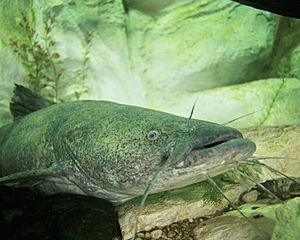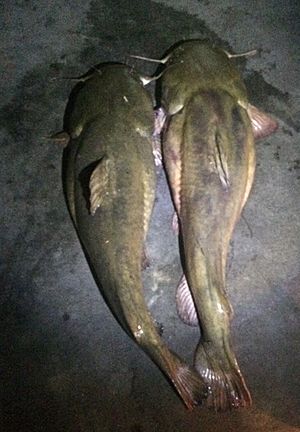Flathead catfish facts for kids
Quick facts for kids Flathead catfish |
|
|---|---|
 |
|
| Conservation status | |
| Scientific classification | |
| Genus: |
Pylodictis
|
| Species: |
olivaris
|
| Synonyms | |
|
|
The flathead catfish (Pylodictis olivaris) is a large species of North American freshwater catfish. You might also hear it called a mudcat or shovelhead cat. It's the only species in its group, called Pylodictis.
These fish live from the Great Lakes area all the way down to northern Mexico. They have also been moved to new places, where they sometimes become an invasive species. This means they can cause problems for other fish that naturally live there. The flathead catfish's closest living relative is a much smaller fish called the widemouth blindcat.
Contents
What are Flathead Catfish Called?
The flathead catfish has many other names. Some people call it the yellow cat, Johnnie cat, or Mississippi cat. Other names include goujon, appaluchion, opelousas, and pied cat.
About the Flathead Catfish
Flathead catfish can grow very big! They can reach up to 155 cm (about 5 feet) long. They can also weigh as much as 56 kg (about 123 pounds). This makes them the second-largest catfish in North America. The blue catfish is the largest.
Most flathead catfish are about 64 to 117 cm (25 to 46 inches) long. They can live for up to 24 years. Male flatheads are ready to have babies when they are about 16 cm (6 inches) long and 4 years old. Females are ready when they are about 18 cm (7 inches) long and 5 years old. Some females might take longer, up to 10 years.
The biggest flathead catfish ever caught with a fishing rod weighed 56.2 kg (123 pounds, 9 ounces). It was caught in Kansas in 1998. Another huge flathead was found in the Arkansas River in 1982. It was 175 cm (69 inches) long and weighed 63.45 kg (139 pounds, 14 ounces).
Where Flathead Catfish Live
Flathead catfish naturally live in a large area west of the Appalachian Mountains. This includes big rivers like the Mississippi, Missouri, and Ohio rivers. Their home range goes as far north as Canada and as far west as Texas. They also live south to the Gulf of Mexico, including parts of northeastern Mexico.
These fish prefer freshwater. They cannot live in very salty ocean water. However, they can survive for a while in slightly salty water. They do best in water with very little salt.
What Flathead Catfish Eat
Flathead catfish love to eat live prey. They are strong hunters and mostly eat other fishes. They also eat insects, worms, and crustaceans like crayfish. They will eat almost anything that moves and makes vibrations in the water.
Young flathead catfish, less than 100 mm (4 inches) long, mostly eat insect larvae. As they grow bigger, their diet changes. They start eating crayfish and small fish. Once they are over 250 mm (10 inches) long, they mostly eat other fish. This can include American gizzard shad, channel catfish, freshwater drum, green sunfish, and carp.
Flathead Catfish Reproduction
Flathead catfish usually lay their eggs in late June and early July. They build their nests in spots with sunken logs or other underwater items. The male catfish builds the nest. He then fiercely protects the eggs and fans them with his fins. This helps keep the eggs clean and healthy.
The number of eggs a female lays depends on her size. On average, a female lays about 2,640 eggs for every kilogram of her body weight.
Young flathead catfish, called fry, like to stay in shallow areas. They look for places with rocks and sand. They eat small insects and worms. Baby flathead catfish can sometimes eat each other. Because of this, it is hard to raise them in fish farms.
Flathead Catfish and People
Flathead catfish live in deep pools, lakes, and large, slow-moving rivers. They are very popular with anglers, which are people who fish with a rod and reel. Many people think their meat is the tastiest of all catfish. Because of their large size, flathead catfish are also good fish to see in public aquariums.
Fishing for Flathead Catfish

Fishing for flathead catfish can be a very exciting hobby! Anglers use different methods, like a rod and reel, or even their bare hands (this is called "noodling"). People fish for them in many places. This includes small rivers, huge rivers like the Mississippi, and large lakes called reservoirs.
Flathead catfish often hide near sunken wood, like logs or tree roots. These spots are usually in bends of rivers. A good fishing spot for flatheads also has deep water and a steady current. It needs to have plenty of smaller fish for them to eat.
Anglers who want to catch big flathead catfish use strong fishing gear. They use long, heavy-duty rods and reels that can hold a lot of fishing line. The line is usually very strong, from 20 to 80 pounds. They prefer to use large live baits. These baits can be fish like river herring, shad, sunfish (like bluegill), suckers, carp, goldfish, drum, or bullheads. These bait fish are usually 5 to 12 inches long.
See also
 In Spanish: Pylodictis olivaris para niños
In Spanish: Pylodictis olivaris para niños


